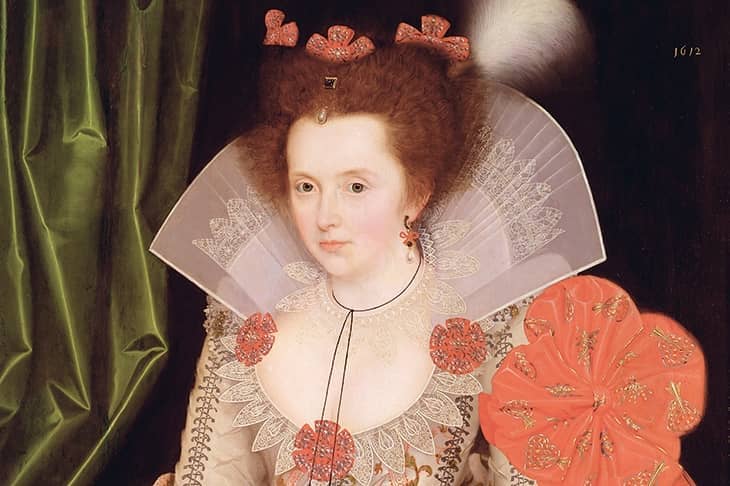Many girls dream about their favourite princesses. Elizabeth Stuart, a princess herself, took this fantasy a step further and modelled herself from childhood on her godmother and namesake, Elizabeth I. The young daughter of James I plucked her hairline to imitate her father’s predecessor, the great Tudor queen.
Aged ten, she was painted with a vivid red wig, dripping in jewels recognisably inherited from her godmother. She even practised her signature until it was almost indistinguishable from Elizabeth I’s famous flourishes. At 13, grandeur got the better of her when she signed herself ‘Elizabeth R’, her most exact copy yet of the queen’s mark. The surviving document shows that someone — perhaps a tactful adult — erased a downstroke from the ‘R’, returning Elizabeth Stuart to her rank as ‘Elizabeth P’, or ‘Elizabeth Principessa’.
Nadine Akkerman is well placed to write about signatures and why they mattered, being an expert on 17th-century letter writing in Europe. Her first book for the general reader was Invisible Agents: Women and Espionage in Seventeenth-Century Britain; and her knack for deciphering codes and uncovering spies’ letters also underpins this doorstopper biography, as she guides us through the network of diplomats and agents that kept Elizabeth Stuart abreast of every twist and turn in the tumultuous history of the age. In her years chasing her subject through the archives, Akkerman has discovered 1,000 untranscribed letters, has cracked nine new codes used by Elizabeth and her friends, and has deciphered 125 encrypted letters.
Many contemporaries thought Elizabeth Stuart would have made a far better ruler than Charles I
Not only did Elizabeth Stuart model herself on Elizabeth I, but throughout her life English writers praised her as that queen’s reincarnation. Underscoring this biography is the implication that they were right to do so, and that the Scottish-born princess could have done a far better job of ruling the three kingdoms than her younger brother, Charles I. But she never got the chance.
A Protestant hardliner, like her short-lived brother Henry but unlike Charles, Elizabeth was married off in 1613 to a minor but strategically important German princeling, the Elector Palatine Frederick V. He took her home to Heidelberg, but soon overreached himself by attempting to add the kingdom of Bohemia to his territories. He lost everything in the ensuing wars, and spent his last days in exile with Elizabeth in the Hague, fretting over money and complaining, as former kings tend to do, about style and precedence.
The marriage was affectionate — though Akkerman plays down the ‘love at first sight’ narrative which once developed around this political match. Elizabeth bore Frederick 13 children, wrote him loving letters, and after his death lived out her remaining 30 years in permanent mourning. Once widowed, she refused to return to her brother’s English court, reasoning correctly that to leave the Continent would mean abandoning her campaign to reclaim the Palatinate for her sons.
Thus she sat out the English civil war in the Hague. Her sons, Maurice and Rupert, fought for Charles, while she herself made vague noises supporting parliament. Akkerman shows that this was a deliberate family strategy to hedge bets on the victor. Eventually, with the restoration of her son to a part of the Palatinate and her nephew, Charles II, to the English throne, Elizabeth returned to die in London.
One of the joys of the book is its descriptions of its heroine engaging with every major European figure of the time: we encounter Cardinal Richelieu (‘this ulcerous priest’), Oliver Cromwell (‘the beast of Revelations… that snake’) and John Donne, whose poem ‘An Epithalamion’ speculated on the consummation of her marriage. We also meet Elizabeth’s adolescent cousin Christian of Brunswick, who careered through hopeless military campaigns to restore her lands, even after losing an arm and replacing it with a sparkling silver prothesis. Akkerman, ever the rationalist, dismisses the story that Christian then sacked a church in ‘iconoclastic frenzy’, melted down its precious metals and minted them as a medallion featuring an image of his hand holding a sword, with the motto altera restat —‘I’ve still got the other one’.
Akkerman’s experience in reconstructing correspondence shines; but she also covers battlefield tactics, banking systems and the technicalities of early modern jewellery-making. Perhaps for readers not versed in the complexities of the seemingly interminable Thirty Years War, she doesn’t quite make clear which petty Germanic towns changed hands at each moment, but that is a near impossible task.
Having established her heroine’s identification with Elizabeth I, she also misses a few correspondences which could have strengthen her argument. Observing the politics of the early civil war, Elizabeth Stuart was surely adapting her godmother’s motto when she wrote: ‘I hear all and say nothing.’ And in her family portrait by Gerard van Honthorst, I suspect her decision to have herself shown trampling a figure of Medusa owed something to a Tudor tradition in which Medusa represented Catholicism, crushed by Elizabeth I.
Generally, however, Akkerman’s sensitivity to literary and cultural symbolism deeply enriches this biography. She decodes the politically charged pageants at Elizabeth’s wedding and shows how her patronage of theatre, long dismissed as a frivolity, was an important way of promoting political messages. After all the macho chevaliers who served her in life, this Elizabeth has found a superb and sisterly champion in death.







Comments